Common oil ratio mistakes that can ruin your soap include using too much coconut oil (keep under 30%), insufficient hard oils (aim for 20-30%), and excessive olive oil (limit to 20-30%). You'll also want to avoid overusing castor oil (stay within 5-10%) and incorrectly calculating superfatting (target 5-8%). Butters should be limited to 5-20% of your formula weight. Balance saturated (30-50%) and unsaturated (50-70%) oils for ideal results. Discover how proper ratios transform your soaping experience.
Common Oil Ratio Mistakes That Ruin Your Soap
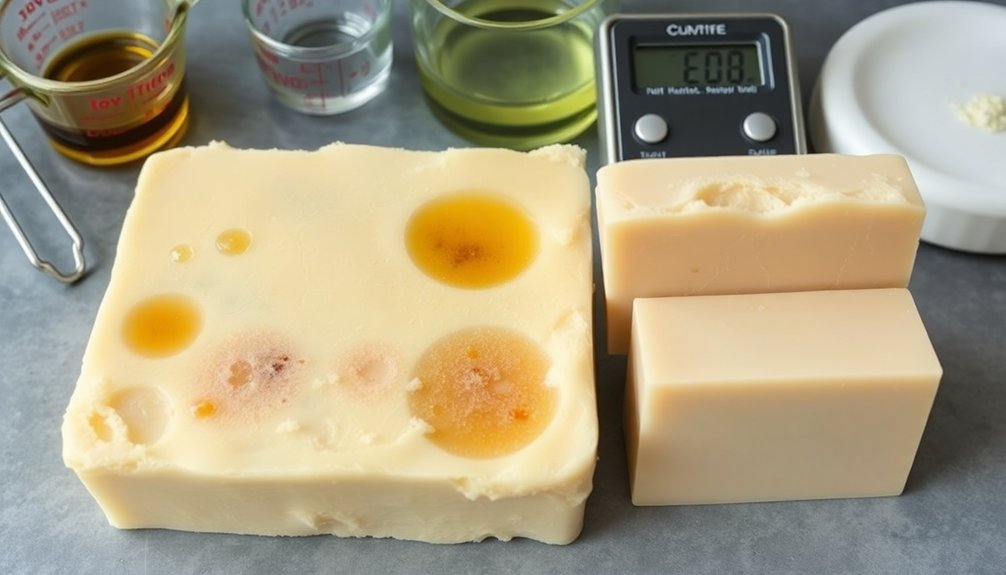
When making homemade soap, precision matters more than creativity. Incorrect oil ratios lead to either lye-heavy soap that irritates skin or overly greasy bars that won't harden properly. Each oil has a unique saponification value that must be respected when formulating recipes.
One of the most common mistakes is using too many soft oils relative to hard oils, resulting in soap that remains mushy. The balance between these determines your soap's hardness and lather quality.
While experimenting is tempting, beginners should stick to proven combinations like 30% olive oil, 30% coconut oil, and 40% palm oil.
Always use a lye calculator when adjusting oil ratios. This essential tool guarantees the proper amount of lye for complete saponification, preventing potential soap failures and guaranteeing safe, effective products.
Too Much Coconut Oil: Creating Overly Cleansing Bars
Although coconut oil creates luxurious lather and hardness in your soap, using too much can transform your creation from skin-nourishing to skin-stripping.
While you might be tempted by its impressive bubbles, exceeding 30% coconut oil in your soap recipe often leads to harsh soap that depletes your skin's natural moisture.
Coconut oil's high sap value can produce lye-heavy soap when overused, potentially causing irritation or burning sensations.
To avoid this common pitfall, balance your formula by incorporating moisturizing oils like olive or sweet almond oil alongside coconut.
For beginners, start with recipes containing modest amounts of coconut oil (15-20%), then adjust based on feedback.
This balanced approach guarantees your bars deliver coconut oil's cleansing properties without compromising your skin's natural barrier.
Insufficient Hard Oils: Why Your Soap Won't Harden
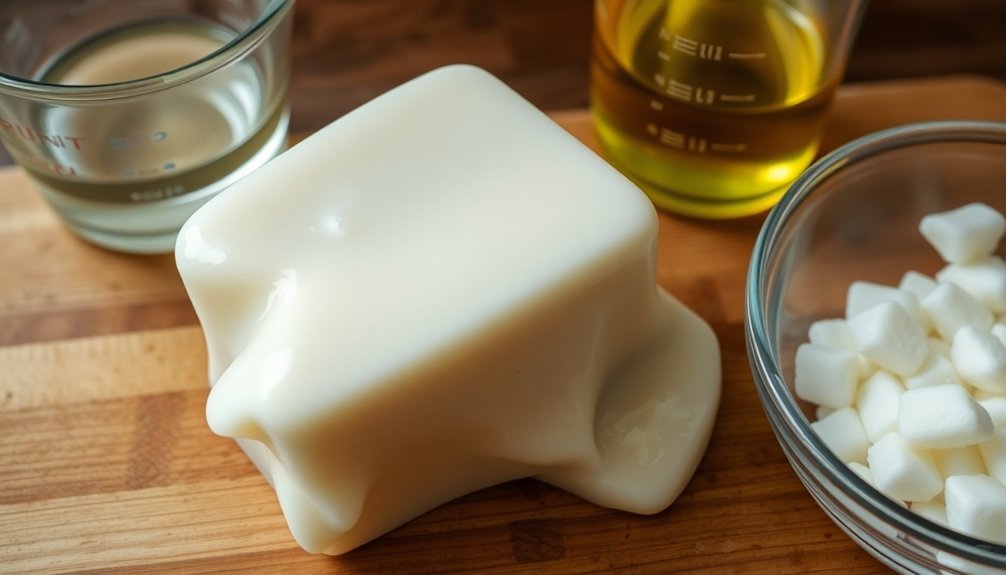
Your soap's failure to harden properly often stems from neglecting the correct balance of fatty acids found in hard oils like coconut and palm.
If you've rushed the curing process or skipped proper temperature monitoring during saponification, you're compromising your soap's structural integrity.
Remember that maintaining appropriate temperatures throughout the soap-making process greatly impacts how well your hard oils set and contribute to the final bar's firmness.
Failing With Fatty Acids
Despite careful measuring and precise temperatures, many soap makers find themselves puzzled by bars that refuse to solidify properly. The culprit often lies in misunderstanding fatty acid profiles in your oils.
Your soap hardens because of the interaction between lye and saturated fatty acids found primarily in hard oils like coconut and palm. Without sufficient hard oils (typically 20-30% of your total formula), the saponification process can't create the firm structure needed for solid bars.
When developing recipes, you're not just combining oils—you're balancing chemistry. Soft oils like olive or sweet almond contribute wonderful properties but lack the structural components that promote hardening.
Always use a lye calculator to adjust formulations based on each oil's unique fatty acid profile. Remember, even small adjustments to your oil ratio can transform a mushy disappointment into a perfectly hardened bar.
Rushed Curing Process
Many soap makers unwittingly sabotage their creations by cutting the curing time short, expecting immediate results from a process that fundamentally requires patience.
Your soap recipe needs 4-6 weeks of proper curing time to allow excess moisture to evaporate and the saponification process to complete. When you rush this essential phase, you're left with a bar that's soft and potentially slimy, especially if you've used a high percentage of soft oils like olive or almond.
Even with sufficient hard oils in your recipe (aim for at least 30% from sources like palm and coconut), you can't circumvent the curing timeline.
The environment matters too—place your soap in a cool, well-ventilated area to optimize hardening. Remember, proper curing isn't just about drying; it's about allowing chemical reactions to fully develop.
Temperature's Crucial Role
Beyond the patience needed for proper curing, temperature management and oil ratios work hand-in-hand to determine your soap's final texture. When you're mixing ingredients, monitoring temperatures becomes essential—both your lye water and oils should remain between 100°F and 110°F for ideal saponification.
| Temperature Affects | Recommended Action |
|---|---|
| Hard oils (20-50%) | Keep temps lower to prevent premature softening |
| Soft oils (50-80%) | Balance with sufficient hard oils for structure |
| Gel phase | Maintain proper temperature for complete transformation |
| Final hardness | Avoid excessive heat that inhibits setting |
If your oils are too hot during mixing, you'll trigger an exothermic reaction that can prevent proper hardening. Remember that insufficient hard oils like coconut or palm won't just affect texture—they'll also impact how your soap responds to temperature fluctuations during the essential gel phase.
Olive Oil Overload: Balancing Conditioning and Firmness
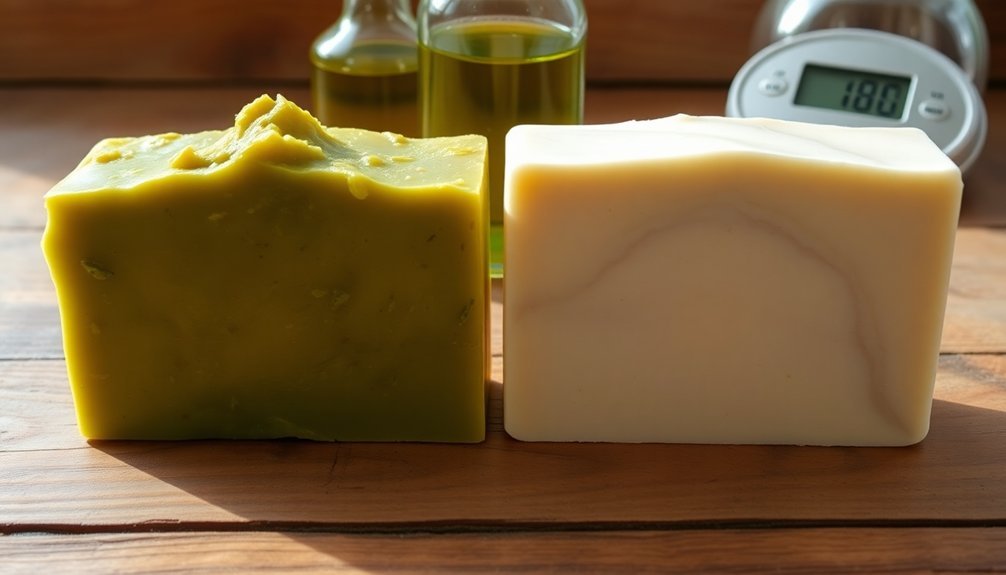
While olive oil contributes wonderful conditioning properties to your soap, using too much can create more problems than benefits.
When you exceed 50% olive oil in your soap recipe, you're likely to end up with bars that remain soft and mushy, dissolving quickly when used.
For best results, limit olive oil to 20-30% of your total oil weight.
Balance it with hard oils like coconut or palm to create a bar with both moisturizing qualities and structural integrity.
This combination guarantees your soap provides skin-nourishing benefits without melting away after a few uses.
Always use a lye calculator when adjusting your oil ratios to determine the correct amount of lye needed, especially when modifying the olive oil content.
This simple step assures firmness while maintaining olive oil's beneficial properties.
Neglecting Superfatting Calculations: Finding the Sweet Spot
Soap makers who overlook proper superfatting calculations risk creating bars that either strip the skin or dissolve too quickly. When you don't account for the extra oils needed to achieve the ideal balance, you'll end up with harsh soap that doesn't properly moisturize.
Using a lye calculator is essential for determining exactly how much lye will saponify your oils while leaving the desired percentage unsaponified. Test small batches to find your sweet spot between 5-8% superfatting.
| Superfatting % | Benefits | Drawbacks |
|---|---|---|
| 0-2% | Cleansing, firmer bars | Potentially harsh, drying |
| 3-5% | Balanced, good lather | Less moisturizing |
| 6-8% | More moisturizing | Shorter shelf life |
| 9-12% | Very conditioning | Soft, quick-dissolving |
| 13%+ | Ultra-moisturizing | May go rancid quickly |
The Single Oil Trap: Why Diversity Matters in Your Formula
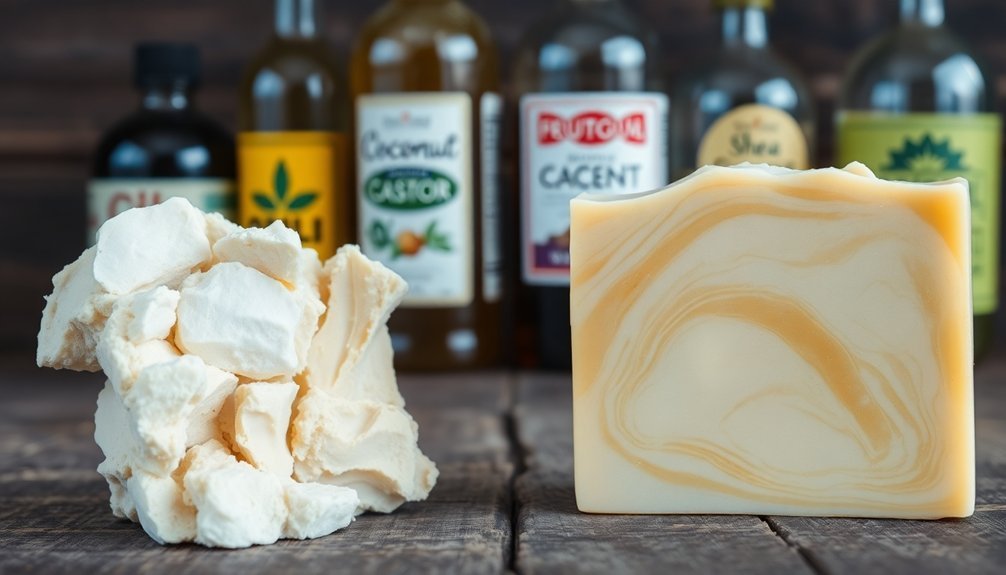
Many beginning soap makers fall into the single oil trap, limiting their formulas to just one fat source and missing out on the complex benefits of oil diversity. A single oil simply can't deliver everything you need – whether it's lather, hardness, or skin benefits.
Creating a diverse oil blend balances these properties for the best results. Combine hard oils like palm or cocoa butter for structure with soft oils such as olive or sweet almond for conditioning properties.
For example, olive oil produces a moisturizing bar, while coconut oil contributes robust lather.
This variety also improves your control over saponification values, ensuring accurate lye calculations and a safe final product.
Misunderstanding Saponification Values: The Chemistry Behind Proper Ratios
Beyond selecting diverse oils, understanding the precise chemistry behind soap making forms the foundation of successful formulation.
Every oil possesses a unique saponification value (SAP value) that determines exactly how much lye is required for complete conversion to soap.
When you miscalculate these values, the consequences are significant. Too much lye creates harsh soap causing skin irritation and burning. Too little results in greasy, soft soap lacking proper hardness.
For instance, olive oil requires 0.134g of KOH per gram of oil—a measurement that must be precise.
Always use a lye calculator to determine the correct amount based on your oil blend. This scientific approach guarantees balanced recipes with ideal properties like proper lather and moisturizing qualities.
The chemistry isn't negotiable—it's the difference between exceptional soap and a failed batch.
Castor Oil Extremes: When Less Is More
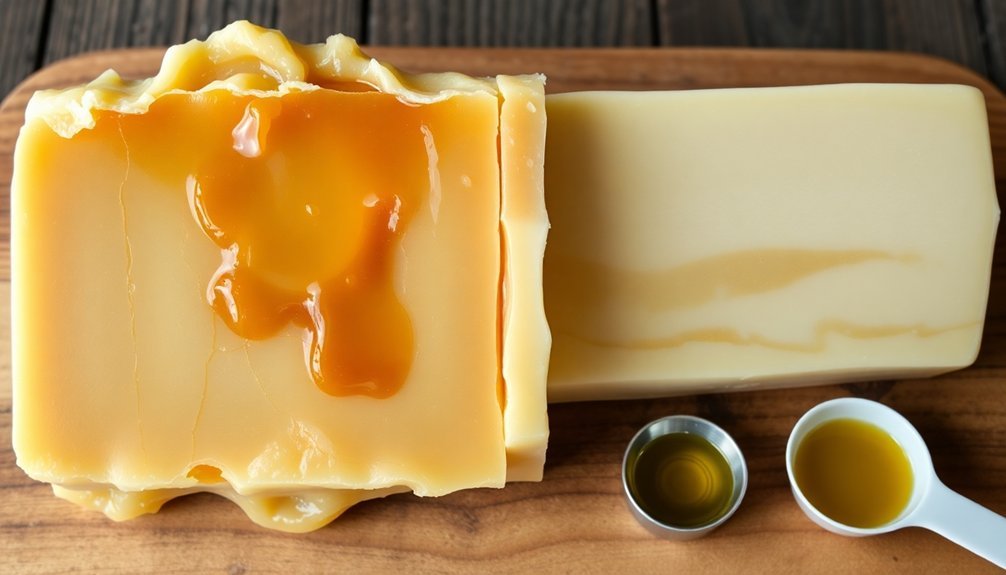
While castor oil represents a powerful addition to soap recipes, misunderstanding its proper proportions remains one of the most common formulation errors among both beginners and experienced crafters.
When you exceed the recommended 5-10% usage rate, you're inviting trouble to your soap creation.
Excessive castor oil leads to:
- A slimy texture that feels unpleasant on skin due to its high humectant properties
- Overly soft bars that won't properly harden, dissolving quickly during use
- Imbalanced cleansing and conditioning properties despite the creamy lather
- Wasted ingredients and time when bars fail to meet high-quality soap standards
Balancing your oil ratios by limiting castor oil while incorporating complementary oils like olive or coconut creates the perfect harmony of lather, hardness, and cleansing power your customers will appreciate.
Luxury Oil Imbalance: Cost vs. Benefit in Your Recipe
Seduced by the allure of exotic and premium ingredients, soapmakers often fall into the luxury oil trap, incorporating excessive amounts of costly oils like argan, jojoba, or evening primrose without reaping proportionate benefits.
While luxury oils offer excellent moisturization properties, they require careful balancing with cost-effective oils to maintain proper saponification ratios. Using too much can backfire, resulting in a softer soap that doesn't harden adequately and deteriorates quickly.
Remember that even small percentages (3-5%) of these premium ingredients can deliver their benefits without compromising your soap's integrity or your budget.
For ideal results, balance luxury oils with workhorses like olive, coconut, and palm. This approach guarantees you'll create superior bars with the perfect blend of luxury and functionality—maximizing benefits while minimizing costs.
Butters Without Balance: Achieving the Perfect Texture
Just as excessive luxury oils can upset your soap's balance, mishandling butter percentages represents another common formulation mistake.
While butters like shea and cocoa create luxurious soap, using too much (over 20% of total oils) often results in bars that remain soft or feel greasy.
For successful soap making with butters, follow these guidelines:
- Limit butters to 5-20% of your total oil weight for proper hardening.
- Balance butters with 30-50% hard oils like coconut or palm for structural integrity.
- Include 30-50% liquid oils such as olive or sweet almond to guarantee balanced lather.
- Test small batches with different butter ratios to discover your ideal texture profile.
Understanding each butter's unique properties helps you create the perfect bar—cocoa butter adds hardness while shea contributes conditioning qualities.
Overlooking Saturated to Unsaturated Oil Ratios
You're risking a brittle, short-lived soap when you ignore the essential balance between saturated oils (20-30%) and unsaturated oils (70-80%) in your formula.
This imbalance directly impacts your soap's hardness, shelf stability, and ability to produce satisfying lather that customers expect.
Using a lye calculator specifically for your oil blend will help you nail the perfect ratio, ensuring your bars maintain an ideal texture while delivering the creamy, abundant lather that sets quality soap apart.
Hard vs. Soft Balance
The delicate balance between hard and soft oils represents one of the most common pitfalls in soap making. Your soap bar's quality depends directly on maintaining proper proportions of saturated oils (hardness) and unsaturated oils (softness).
When you miscalculate this balance, you'll notice:
- Too many saturated oils (>50%) creates overly hard, crumbly soap that lacks sufficient lather.
- Excess unsaturated oils (>70%) results in soft, greasy bars that feel slimy and don't harden properly.
- Ideal formulations use 30-50% saturated oils with 50-70% unsaturated oils.
- Each oil's unique properties affect the final saponification results and texture.
Always use a lye calculator to determine precise oil ratios for your recipe. This preventative step guarantees your soap achieves the perfect balance between cleansing power and moisturizing properties.
Shelf Life Considerations
Three critical factors determine your soap's shelf life, with oil ratios standing as perhaps the most overlooked.
When you don't balance saturated and unsaturated oils properly, you're setting your soap up for premature deterioration.
Saturated oils like coconut and palm provide the stability your bars need, while unsaturated oils contribute moisturizing properties but increase rancidity risk.
For ideal results, include a high percentage (at least 20-30%) of saturated oils in your formulation.
Be especially cautious with polyunsaturated oils like flaxseed or sunflower—they're the first to spoil.
Even with perfect technique, using rancid oils guarantees disappointing results and off-putting scents.
Always check your oils' freshness before soap making, as no amount of additives can rescue a batch made with compromised oils.
Lather Quality Issues
Many soap makers struggle with lather quality because they've misunderstood the essential balance between saturated and unsaturated oils. This common mistake undermines your soap's performance and feel.
A well-balanced soap requires:
- Proper ratio – Aim for 30-50% saturated oils (coconut, palm) and 50-70% unsaturated oils (olive, sweet almond)
- Controlled coconut oil – Keep it between 20-30% for robust lather without excessive drying
- Moderate olive oil – Limit to 50-70% to avoid sacrificing bubbles for creaminess
- Careful formulation – Calculate saponification values to prevent lather quality issues
When you neglect these oil ratios in soap making, you'll either end up with harsh, drying bars (too much saturated oils) or soft, greasy soap with poor lathering abilities (excessive unsaturated oils).
Essential Oil Dilution Errors: Calculating Safe Amounts
While crafting the perfect soap requires attention to numerous details, understanding essential oil dilution ratios stands as perhaps the most critical safety consideration. You'll need to maintain a 2-5% essential oil concentration of your total oil weight to prevent skin irritation.
For proper dilution, always use a digital scale—never measure by volume. A 1,000g batch requires just 20-50g of essential oil, depending on potency.
| Batch Size | 2% Dilution | 3.5% Dilution | 5% Dilution |
|---|---|---|---|
| 500g | 10g | 17.5g | 25g |
| 1000g | 20g | 35g | 50g |
| 1500g | 30g | 52.5g | 75g |
| 2000g | 40g | 70g | 100g |
Before scaling up production, create a test batch with new essential oils to verify their performance and compatibility with your skin.
Batch Size Miscalculations: Scaling Recipes Properly
Scaling your soap recipe isn't as simple as doubling all ingredients, as proportion problems can emerge when lye-to-oil ratios aren't precisely calculated.
While you might be tempted to do the math manually, always use a specialized lye calculator to guarantee proper saponification when adjusting batch sizes.
Start with small test batches before committing to larger quantities, allowing you to identify potential issues with temperature changes and equipment capacity.
Doubling Creates Proportion Problems
When soapmakers double a recipe without properly recalculating the oil-to-lye ratios, they're setting themselves up for disappointment.
Simply multiplying ingredient amounts doesn't account for the complex saponification chemistry that makes great soap.
When you scale up your batch size, you'll need to:
- Use a lye calculator to determine the exact lye requirements for your new oil quantities
- Maintain your desired superfatting level (typically 5%) in the larger batch
- Measure all oils by weight, not volume, to guarantee precise proportions
- Recalculate each individual oil's lye requirement based on its unique saponification value
Remember that each oil reacts differently with lye.
Doubling everything without proper recalculation can result in soap that's either dangerously lye-heavy or disappointingly greasy and soft.
Calculator Versus Manual Math
Many experienced soapmakers trust their instincts over mathematics, only to discover that precision tools surpass memory every time. When you scale recipes, relying on manual calculations can introduce significant errors.
Even small miscalculations in oil ratios can transform your luxurious soap into an unusable mess. Always use a lye calculator to determine the correct amount of lye based on your adjusted amount of oils. These tools guarantee proper saponification regardless of batch size changes.
Remember, doubling everything isn't always the right approach—each ingredient must be precisely recalculated. Convert all measurements to weight rather than volume when scaling, as oil densities vary considerably.
Before committing to large batches, create small test samples and keep detailed testing notes. This methodical approach helps you scale recipes successfully while maintaining your soap's desired properties.
Small Test Batches First
Experienced soapmakers often rush into large batches before confirming their formulations work, leading to costly mistakes and wasted ingredients.
When scaling recipes, always begin with small test batches to perfect your formula before committing to larger quantities.
Follow these steps to avoid batch size miscalculations:
- Start with 500g or less of total oils to test the right amount of each ingredient.
- Use a lye calculator specifically for your batch size, as the high percentage of hard oils can affect lye requirements.
- Maintain proportional ratios when scaling recipes up or down to guarantee proper saponification.
- Focus on weighing ingredients precisely rather than using volume measurements.
Small test batches first not only save money but also give you confidence in your formulation before scaling up to full production size.
Frequently Asked Questions
What Happens if You Put Too Much Fragrance Oil in Soap?
If you put too much fragrance oil in soap, you'll face accelerated saponification, poor emulsification, increased skin irritation risks, potential discoloration, and compromised quality. Your soap won't set properly and may become unusable.
What Oils Make the Hardest Soap?
You'll create the hardest soaps using palm oil, coconut oil, and tallow. These saturated fats produce firm bars when saponified. Adding stearic acid enhances hardness, while limiting soft oils like olive and castor.
What Percentage of Fragrance Oil Should Be in Soap?
You'll want to use 5-7% fragrance oil based on your total oil weight. Don't exceed this range as too much can cause overheating, while too little won't provide enough scent throw in your soap.
What Is the Best Water Ratio for Soap Making?
You'll find the best water ratio for soap making is typically 30-38% of your total oils by weight. A 2:1 water-to-lye ratio works well, ensuring proper saponification without creating soft or irritating soap.
In Summary
By avoiding these common oil ratio mistakes, you'll transform your soap making from frustrating failures to reliable successes. Remember to balance cleansing and conditioning properties, calculate your superfat carefully, and maintain proper hard-to-soft oil ratios. Don't forget to measure essential oils accurately and scale recipes correctly. With practice and attention to these details, you're well on your way to creating perfect, luxurious soap bars every time.

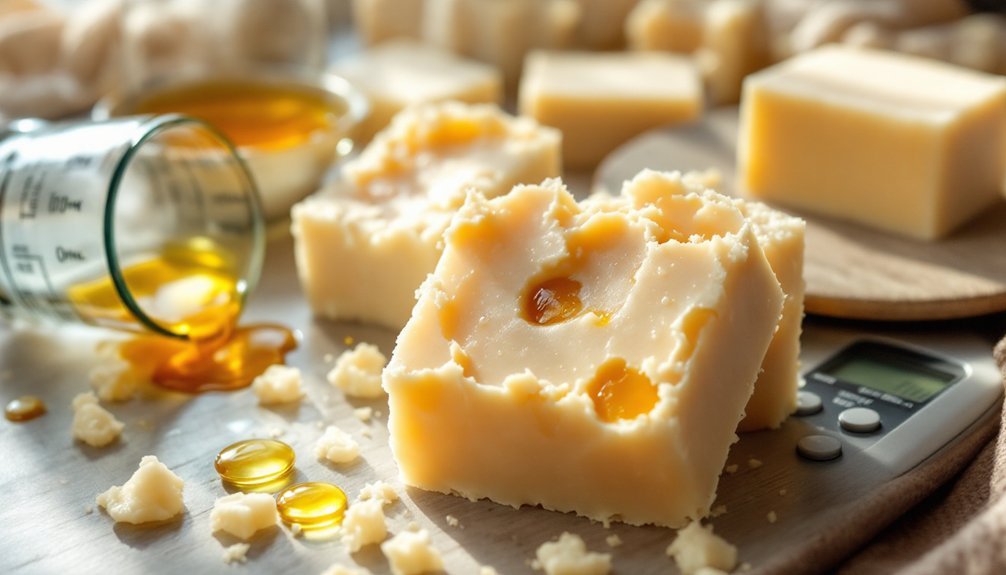



Leave a Reply